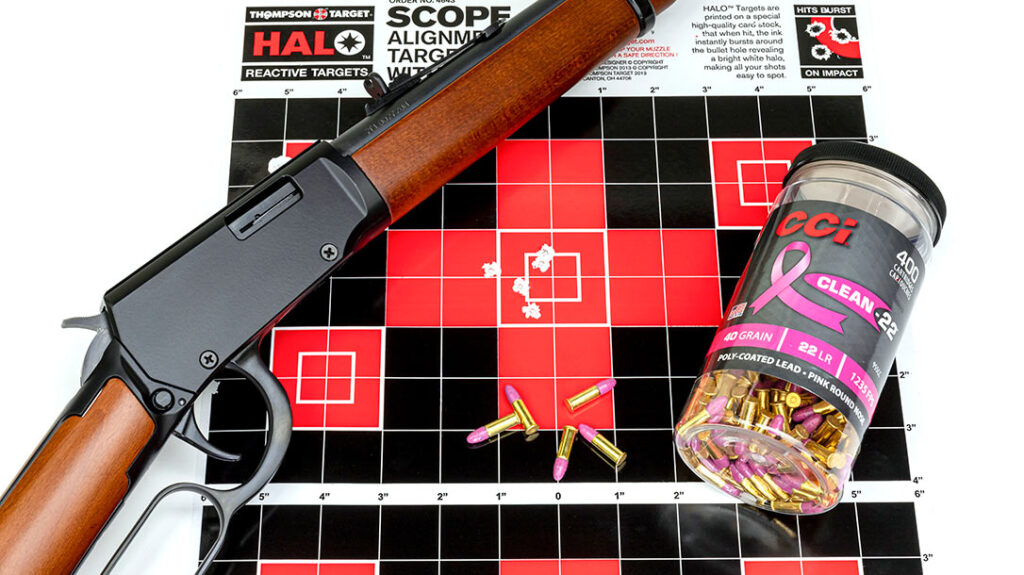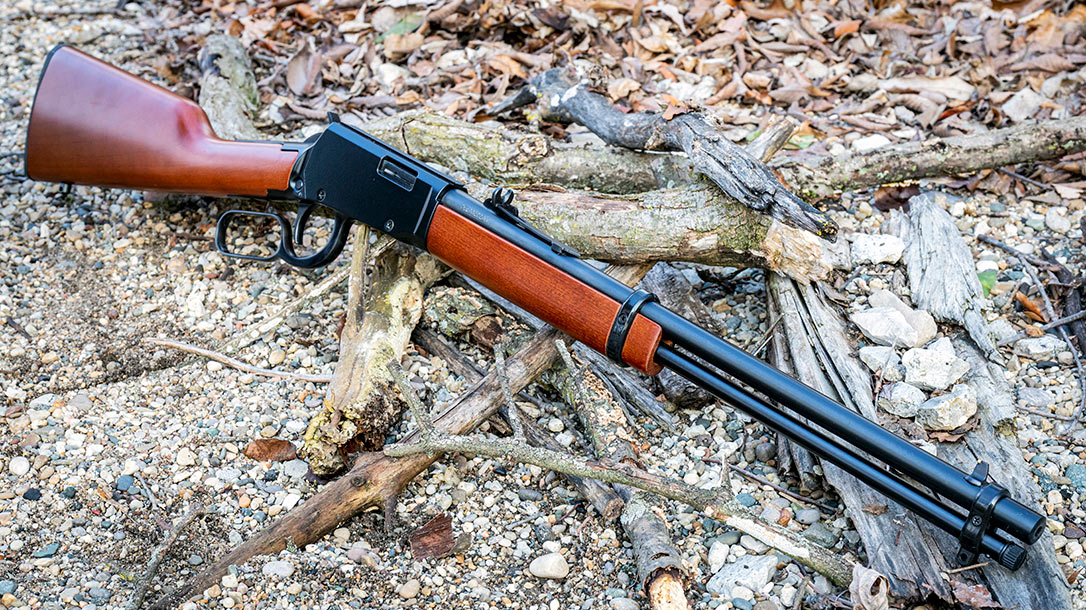Americans, both the North and South variety, have had an affinity for lever-action long guns since they were perfected some 160 years ago. The lever gun is uniquely American and initially gained popularity during the era of the Old West. And lever action .22 LR rifles, like the Rio Bravo from Rossi, make shooting both fun and affordable.
The Rossi Rio Bravo in .22 LR
Cowboys, settlers, lawmen, and outlaws took to the lever-action rifle for its firepower, fast handling, and ease of use. Its popularity extended up to Canada and down through Mexico, into Central and South America. Whether you were a cowboy, vaquero or gaucho, you probably had a lever gun in a scabbard attached to your saddle.
While most lever-action rifles and carbines were manufactured in the United States, there were some outfits “south of the border” that also began producing them. Amadeo Rossi entered into the firearms production field in 1889.
Advertisement — Continue Reading Below
Many readers will be familiar with their rendition of the Model 1892 lever-action rifle. I have two—one in .357 Magnum and one in .45 Colt—and both have served me well for years.
Today, Rossi builds firearms in a modern facility in San Leopoldo, Brazil. Once distributed by Interarms, BrazTech International has been importing Rossi guns since December 1997.
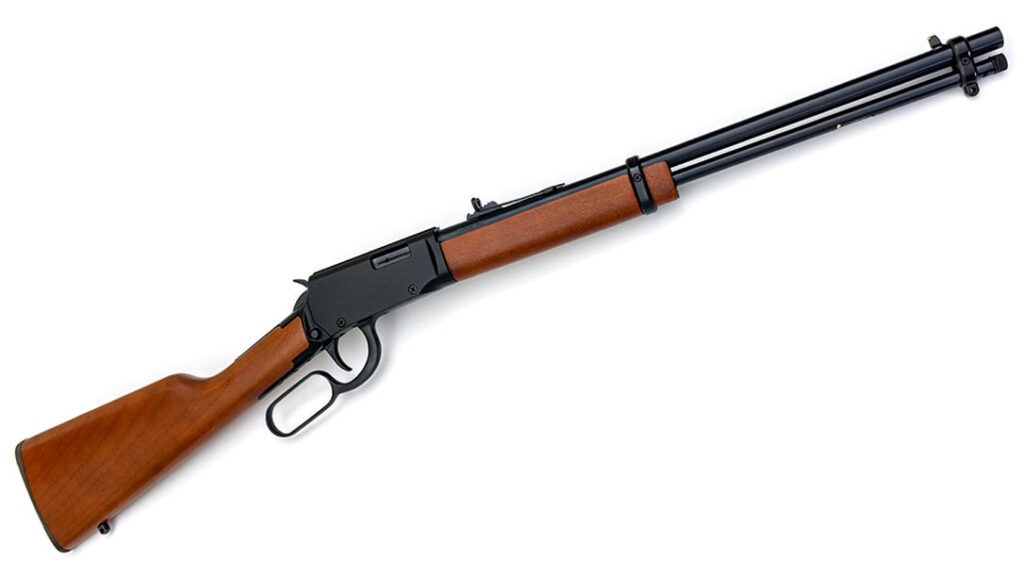
Advertisement — Continue Reading Below
Details of the Rio Bravo
Rio Bravo is another name for the Rio Grande River, which separates Texas from Old Mexico. It is also the name of a classic John Wayne Western movie, circa 1959. The movie was filmed on the set at Old Tucson near Tombstone, Arizona. It’s always been one of my favorites.
So, in my opinion, Rossi picked a very appropriate name for their new lever-action rifle, the Rio Bravo. A moniker that stirs the imagination to westward locales. Based on the company’s popular line of R92 lever guns, this new rifle is chambered for the ever-popular and economical .22 LR cartridge.
There are actually two versions of this new long-gun. One has the “tactical look” with a black synthetic stock and fiber-optic sights. However, the version I will be evaluating is the more traditional of the two and has a straight-wristed stock fashioned from German beechwood.
Advertisement — Continue Reading Below
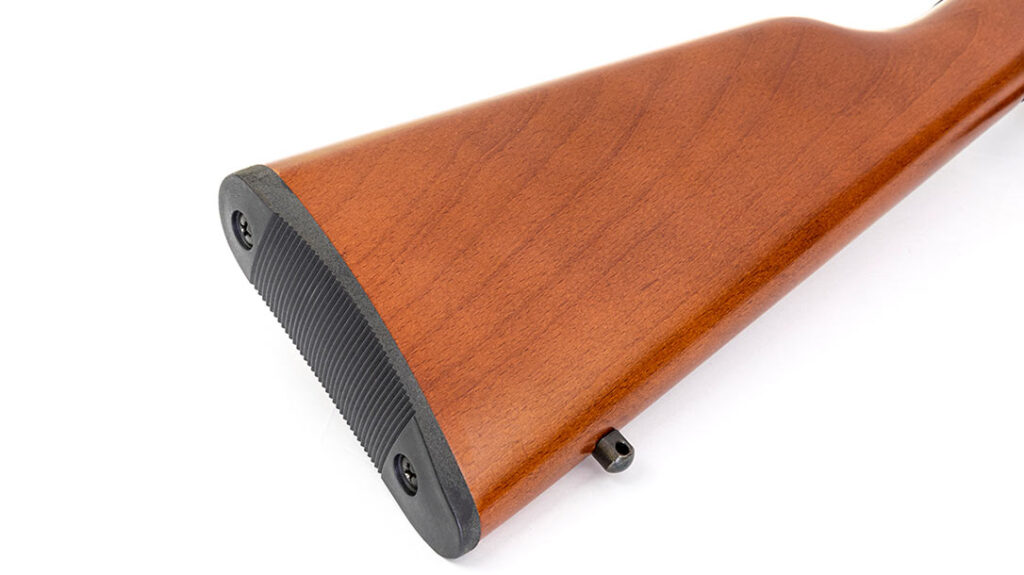
The wood is pretty “plain Jane,” but not altogether unattractive. Rossi’s description of the metal finish is “polished black.” It appears to me that the steel parts are satin blued and those parts in the “other metal” category, like the receiver, have a black coating.
A couple of other parts like the barrel bands and butt plate are black plastic. Overall, looking from stem to stern, fit and finish are in the “pretty decent” category.
Advertisement — Continue Reading Below
A Feature Rich Lever Action
As to features, the Rio Bravo has an 18-inch barrel, and the tubular magazine beneath it holds 15 rounds of .22 LR cartridges. The magazine inner tube is brass with a red follower and a knurled cap for easy removal.
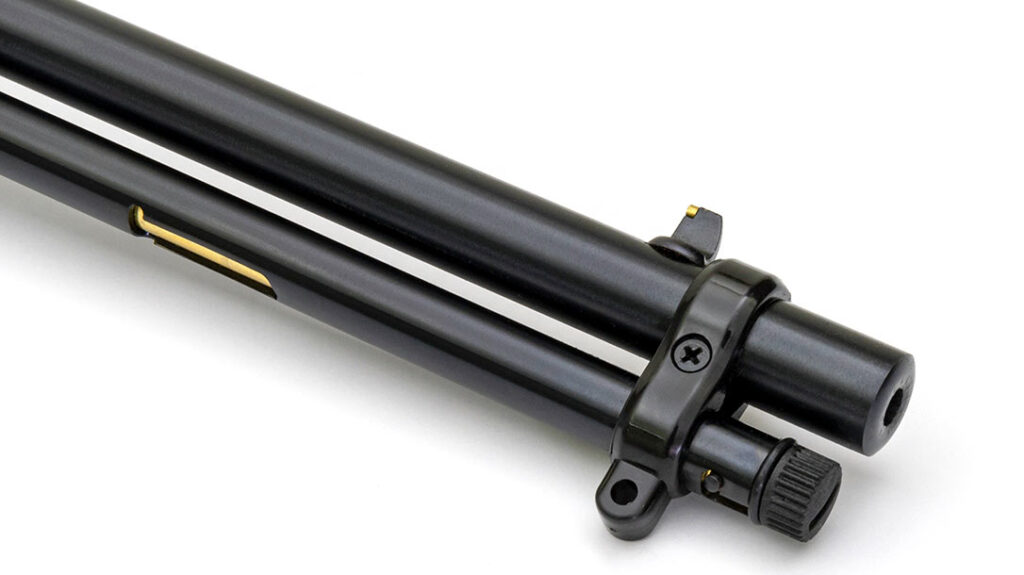
Additionally, the front sight, dovetailed into the barrel, is the post-type with a brass bead. The rear sight, also affixed into a dovetail, is a buckhorn style that’s step-adjustable for elevation. Either front or rear sight can be moved laterally in its dovetail for windage adjustment.
Advertisement — Continue Reading Below
A Weaver rail is integral with the top of the receiver for mounting optics. The upper surface of said rail features serrations to reduce glare.
The Rio Bravo has an interesting safety arrangement. Just above the trigger, at the rear of the receiver is a push-button, cross-bolt safety. When in the off or fire position, it protrudes from the left side of the receiver and exposes a blaze-orange band.
Pushing the safety from left to right accomplishes three tasks—the trigger is locked, the hammer won’t cock and the lever will only move down slightly, but won’t open the action. The hammer has no ¼-cock notch.
Advertisement — Continue Reading Below
Operating the Rio Bravo
The Rio Bravo operates like all lever-actions. Working the lever down opens the bolt for feeding a cartridge or ejecting an empty cartridge case. It also cocks the hammer. Raising the lever closes the bolt, simultaneously feeding a round into the chamber.
There’s an ejection port in the right side of the receiver. The hammer spur features deep serrations, and there’s a long, smooth-faced trigger. Pulling the trigger reveals about ½ inch of take-up, with just a little creep and ¼ inch of overtravel. My Lyman trigger pull gauge measured the average pull weight at 6.6 pounds.
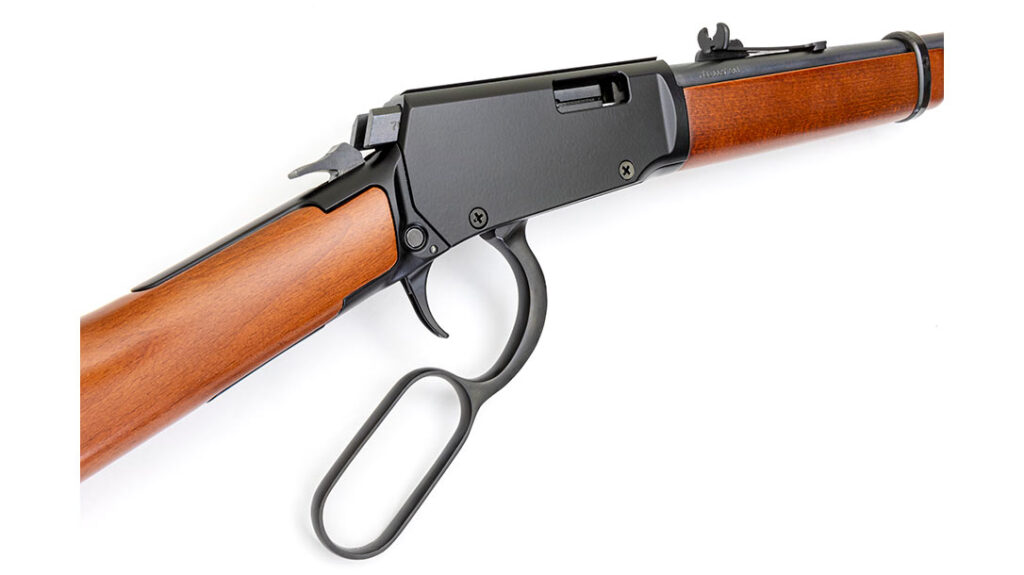
Advertisement — Continue Reading Below
There are studs for sling swivels near the toe of the butt and also on the forward barrel band, which is attached ahead of the front sight. The butt plate features serrations for good shoulder purchase.
Turing the knurled cap on the magazine tube unlocks the inner tube so it can be slid forward. This allows cartridges to be fed into a port cut into the magazine tube. The inner tube is then pushed back into place and relocked.
Prep Work
It’s a well-known fact that guns in .22 rimfire can be persnickety and often partial to particular makes or types of cartridges. For this reason, I selected five different brands of .22 LR ammunition for my Rio Bravo testing and evaluation.
Advertisement — Continue Reading Below
Discussed in alphabetical order, the first was from Armscor (made in the Philippines) and had a 36-grain HP gold-tone bullet, listed as high velocity. CCI provided their Clean-22 cartridges, which had a 40-grain solid bullet with a pink-colored, polymer coating.
Next was Federal’s Premium Hunter Match load. It has a 40-grain HP bullet and a nickel-plated case. Remington’s entry was their well-known ThunderBolt loading, popular with plinkers and featuring a 40-grain solid bullet. Last was the Winchester M-22 cartridge. Another plinking/target round, it has a 40-grain solid bullet with a black copper plating.
I went through my stock of paper targets and selected a package of Scope Alignment Targets from Thompson Target. These feature two-on-one-sheet red cross aiming points, with four additional red squares connected to the cross on a black background, with a 1-inch grid. These are reactive “halo” targets that encircle the bullet holes in a white halo for easy shot spotting.
A second kind of target I chose to use was a reduced-size humanoid silhouette from Birchwood Casey. This Dirty Bird “Splattering” target also outlines the bullet hole in white, and my old eyes appreciate the help.
The Rio Bravo at the Range
I headed to the range just four days into 2021, with the weatherman forecasting sunshine and highs in the mid-40s. The first order of business was to see what kind of velocities I would get from the 18-inch barrel of the little Rossi rifle.
To this end, I set up my Oehler Model 35P chronograph to do the measurements. It was interesting to note that of the five .22 LR loads, the velocities were pretty close together. They had an average low of 1,127 feet per second (fps) to a high of 1,185 fps.
With the velocity figures recorded, I put my sandbag on the range’s solid bench, then positioned my target stand with the attached Thompson Target at 25 yards. I felt this would be a reasonable distance for an open-sighted .22 long gun.
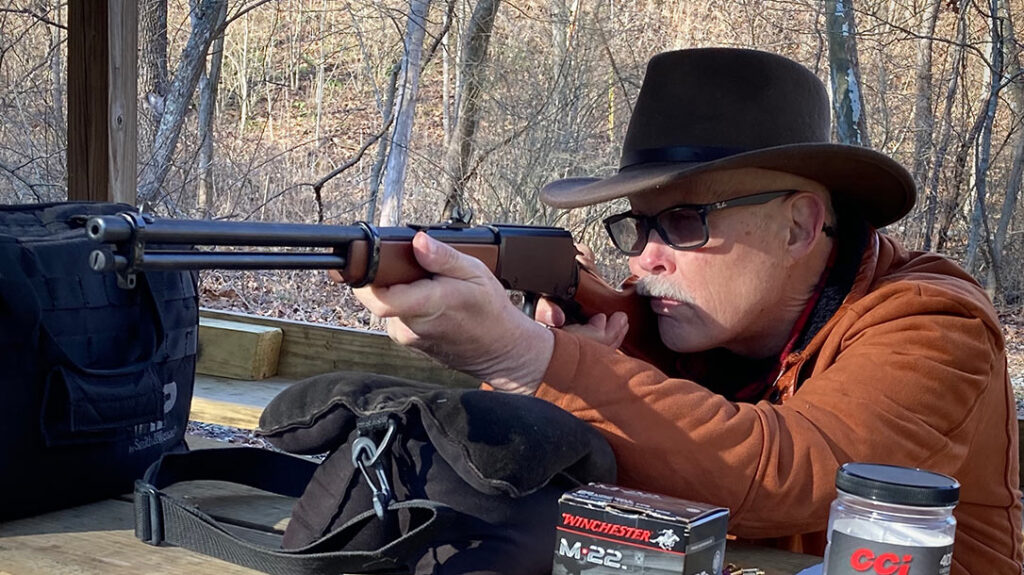
Rifle targets in Cowboy Action Shooting match stages are generally within this distance. And .22 lever-guns are SASS-legal for the Buckeroo (kids) category and .22 side matches.
I noted after my first few shots that the sights were set for a 6 o’clock hold on the aiming point. Windage seemed to be just fine. My tightest five-shot group measured 1.19 inches and was made using the CCI Clean-22 load.
Second place went to the Winchester M-22, with a five-shot cluster “miked” at 1.21 inches. None of the group averages went over 2 inches, and the biggest was 1.82 inches with the Armscor .22 fodder. Complete data is located in the performance table below.
Doubling the Distance
I was interested in seeing what the Rossi Rio Bravo, with me as a handicap, could do at double that distance. So, I took the target stand out to 50 yards and put up the Dirty Bird silhouette target.
From the bench, I could barely make out the 3-inch tall red oval in the center of the target. Again, shooting off the sandbag rest, I put the front sight at what looked like the center of the oval and let fly.
I’d loaded the Rio Bravo with three rounds each of the test ammo, mixed up, for a total of 15 cartridges. When the smoke cleared, I went downrange and discovered a “group” of about 4.5 inches. Out of 150 possible points, I scored 147, with one hit in the 3 and 4 rings, plus 7 in the red X-oval.
Loading up the Rio Bravo to full capacity, I repaired back to the cowboy section of the range to engage some steel rifle targets. I placed the yellow-painted targets up on the hillside at distances varying from 25 to 30 yards.
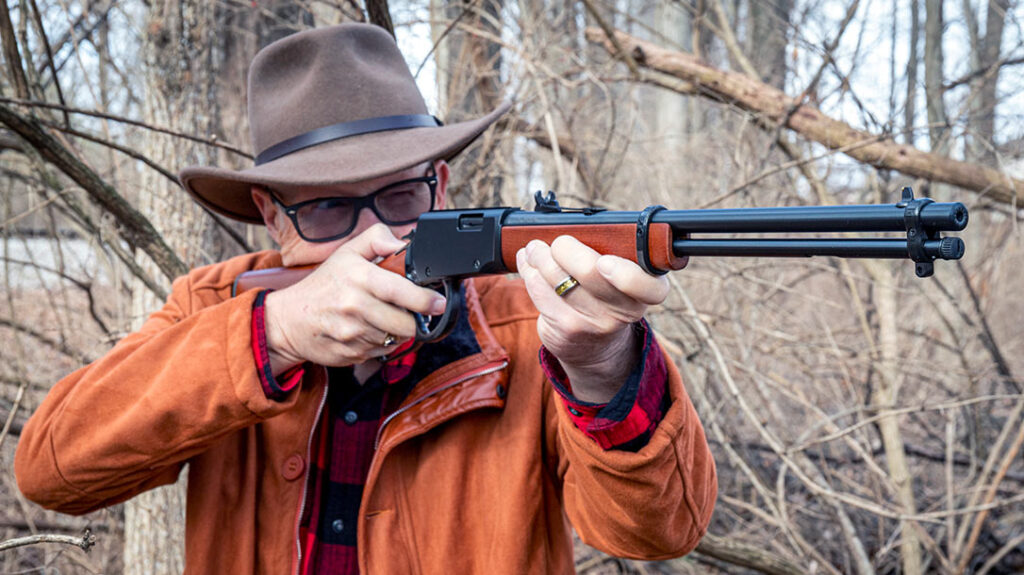
I engaged the targets in a “Nevada Sweep,” shooting left to right, then right to left and back until my 15 rounds were expended. No misses were recorded.
I loaded up the rifle once more and engaged a closer-in target. The goal was to test functional reliability. To this end, I worked the lever and pulled the trigger as fast as I could. Plus, I turned the rifle sideways, ejection port up and then down. This exercise was repeated twice more.
Final Revelations
I had noted at the bench that the beechwood forend was a bit loose and had about 1/8 inch of forward/backward movement. During the accuracy potential evaluation, I had two misfires. I’m going to blame the ammunition as the rims of both cartridges were impressively dented. And the incidents were confined to only one brand of ammo.
I noted when putting 15 rounds in the magazine tube that sometimes the tube cap could not be pushed down far enough to lock. When this happened, I’d lever in a round, then safely lower the hammer, and apply the safety. Then I added a cartridge into the magazine.
Functionality left nothing to be desired, and there were no hiccups with feeding. Empty cases were extracted and ejected with aplomb.
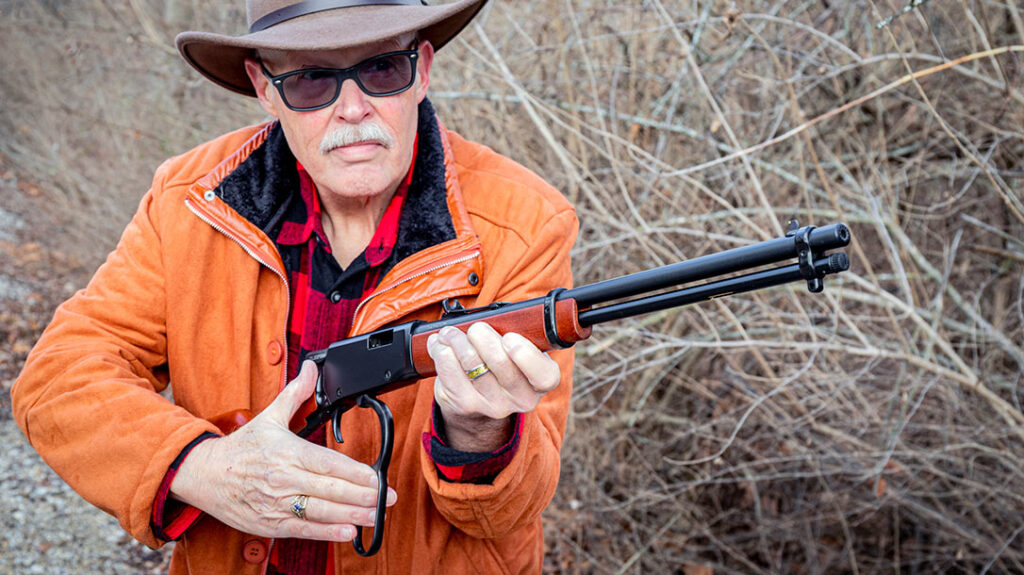
My most strident criticisms would be in the category of aesthetics. Phillips head screws just do not belong on a gun—especially on the receiver. It gives the Rio Bravo the appearance of a budget BB gun.
I also took exception to the shiny, black plastic barrel bands. Numero uno, they are tacky-looking. Second, they might not hold up if the rifle were to be dropped on a hard surface. However, due to the accuracy and reliability of the Rio Bravo, I can overlook a couple of minor faults.
If you are looking for an economical .22 lever gun that will perform a variety of tasks well, then the Rossi Rio Bravo will most certainly fulfill your needs.
For more information, please visit RossiUSA.com.
Rossi Rio Bravo Specs
Caliber: .22 LR
Barrel: 18 inches
Overall Length: 36 inches
Weight: 5.5 pounds (empty)
Stock: German beechwood
Sights: Brass bead post front, adj. buckhorn rear
Action: Lever
Finish: Polished black
Capacity: 15+1
MSRP: $367
Performance
| LOAD | VELOCITY | ACCURACY |
| Armscor 36 HV-HP | 1,162 | 1.46 |
| CCI Clean-22 40 RN | 1,166 | 1.19 |
| Federal Hunter Match 40 HP | 1,172 | 1.23 |
| Remington ThunderBolt 40 RN | 1,185 | 1.50 |
| Winchester M-22 40 RN | 1,127 | 1.21 |
Bullet weight measured in grains, velocity in feet per second (fps) by chronograph and accuracy in inches for best five-shot groups at 25 yards.
This article was originally published in the Guns of the Old West Fall 2021 issue. Subscription is available in print and digital editions at OutdoorGroupStore.com. Or call 1-800-284-5668, or email subscriptions@athlonmediagroup.com.
